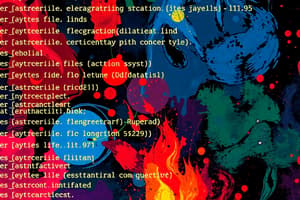Podcast
Questions and Answers
What does the exec() system call do in the process lifecycle?
What does the exec() system call do in the process lifecycle?
- Changes the currently running program (correct)
- Creates a new process
- Terminates the process
- Opens a file in read mode
The process returns to user mode after calling a system call.
The process returns to user mode after calling a system call.
True (A)
What is created when a file is opened through the open() system call?
What is created when a file is opened through the open() system call?
An inode
The standard library for C programming language is called ______.
The standard library for C programming language is called ______.
Match the following file operations with their corresponding actions:
Match the following file operations with their corresponding actions:
Which of the following describes the purpose of shared libraries?
Which of the following describes the purpose of shared libraries?
The write() system call switches the process to user mode.
The write() system call switches the process to user mode.
What is the initial mode when a process is created?
What is the initial mode when a process is created?
What is the main purpose of lazy binding in operating systems?
What is the main purpose of lazy binding in operating systems?
Lazy binding resolves the address of a function at compile time.
Lazy binding resolves the address of a function at compile time.
What happens when a function is called using lazy binding for the first time?
What happens when a function is called using lazy binding for the first time?
In lazy binding, the initial call to a shared function points to the _________ resolver code.
In lazy binding, the initial call to a shared function points to the _________ resolver code.
Match the following components of lazy binding with their roles:
Match the following components of lazy binding with their roles:
Which of the following statements about shared libraries is true?
Which of the following statements about shared libraries is true?
The Global Offset Table (GOT) maintains the default addresses of all functions in shared libraries.
The Global Offset Table (GOT) maintains the default addresses of all functions in shared libraries.
Describe the role of the Global Offset Table (GOT) in lazy binding.
Describe the role of the Global Offset Table (GOT) in lazy binding.
The performing of _________ minimizes the need to recompile code each time a library is updated.
The performing of _________ minimizes the need to recompile code each time a library is updated.
What does the process of deferred binding primarily enhance?
What does the process of deferred binding primarily enhance?
What is the main advantage of using shared libraries?
What is the main advantage of using shared libraries?
Shared libraries are fixed in memory addresses across different processes.
Shared libraries are fixed in memory addresses across different processes.
What is the role of the dynamic linker in relation to shared libraries?
What is the role of the dynamic linker in relation to shared libraries?
Shared libraries are shared among all processes using them through __________.
Shared libraries are shared among all processes using them through __________.
Match the following functions with their respective roles in the context of shared libraries:
Match the following functions with their respective roles in the context of shared libraries:
When does the dynamic linker resolve the address of a shared function?
When does the dynamic linker resolve the address of a shared function?
Static linking improves memory usage compared to shared libraries.
Static linking improves memory usage compared to shared libraries.
What is the first action taken by an executable in UNIX systems using ELF format?
What is the first action taken by an executable in UNIX systems using ELF format?
The dynamic linker is tasked with __________ shared libraries needed by the program.
The dynamic linker is tasked with __________ shared libraries needed by the program.
Which of the following statements is true regarding shared libraries?
Which of the following statements is true regarding shared libraries?
What does a process control block (PCB) represent in an operating system kernel?
What does a process control block (PCB) represent in an operating system kernel?
The system call kill() can be used to send a signal to terminate processes.
The system call kill() can be used to send a signal to terminate processes.
What is the purpose of shared libraries in an operating system?
What is the purpose of shared libraries in an operating system?
In process communication, a process can send a signal using the system call kill() with the argument _____ for stopping the process.
In process communication, a process can send a signal using the system call kill() with the argument _____ for stopping the process.
Match the following terms with their descriptions:
Match the following terms with their descriptions:
What does the Procedure Linkage Table (PLT) contain?
What does the Procedure Linkage Table (PLT) contain?
Lazy binding resolves all relocations when the program starts.
Lazy binding resolves all relocations when the program starts.
What is the purpose of the Global Offset Table (GOT)?
What is the purpose of the Global Offset Table (GOT)?
Eager binding also known as __________ binding, resolves all relocations when the program starts.
Eager binding also known as __________ binding, resolves all relocations when the program starts.
Match the following components with their descriptions:
Match the following components with their descriptions:
Which of the following strategies requires restructuring the GOT during program start?
Which of the following strategies requires restructuring the GOT during program start?
The dynamic linker typically uses information in the ELF header for linking operations.
The dynamic linker typically uses information in the ELF header for linking operations.
What information does the ELF header primarily provide for linking operations?
What information does the ELF header primarily provide for linking operations?
When a shared library function is called, it jumps to the corresponding ______ entry that directs it to the address in the GOT.
When a shared library function is called, it jumps to the corresponding ______ entry that directs it to the address in the GOT.
Which of the following best describes the initial action of the dynamic linker?
Which of the following best describes the initial action of the dynamic linker?
Flashcards are hidden until you start studying
Study Notes
File Manipulation Process
- Process creation involves forking from a parent process, copying its PCB.
- The
exec()system call is used to replace the current process image with a new program. - Default file descriptors opened are stdin, stdout, and stderr.
- The
open()system call is made to access "foo.txt" in write-only mode, transitioning to supervisor mode. - An inode is created which allocates necessary blocks on the device.
- A file descriptor pointing to the inode is formed, initialized with mode and offset 0, and linked to the file table in the PCB.
- Following the write operation through
write(), the kernel accesses the file descriptor and locates the appropriate block for data writing.
Shared Libraries
- Shared libraries prevent code duplication in memory by allowing multiple programs to use the same library simultaneously.
- Libraries like libc for C are common, where static linking would lead to wasted memory across multiple binaries.
- Memory mappings (via
mmap()) facilitate shared usage of libraries.
Function Resolution in Shared Libraries
- The address of a shared function can differ across processes due to individual mappings in their virtual address spaces.
- Dynamic linkers facilitate the loading and linking of shared libraries and functions at runtime, not at compile time.
Dynamic Linker Operations
- The dynamic linker is essential for loading the binary into memory, setting up the memory layout, and loading necessary shared libraries during program execution.
- Example shows how a program using
printf()translates to assembly code that accesses a shared library.
Lazy Binding
- Lazy binding resolves function addresses only upon the first call, utilizing the Procedure Linkage Table (PLT) and the Global Offset Table (GOT).
- The initial call routes through the relocation resolver, which updates the GOT for subsequent calls to directly access the correct function address.
- Linking operations rely on ELF header information, identifying necessary symbols and relocation data.
Eager Binding
- Eager binding resolves all relocations when a program starts, modifying entries in the GOT for functions and variables.
- On function calls, the program jumps to the corresponding entry in PLT leading directly to the address in the GOT.
User-Kernel Interactions
- A process is defined within the kernel by its process control block (PCB).
- User-space programs interact with the kernel through integer values for system calls, virtual addresses for memory management, and file descriptor tables for file operations.
Signal Handling Example
- Process 1 can send a STOP signal to process 2 using the
kill()system call, which involves transitioning to supervisor mode and setting appropriate bits in the pending signals of process 2.
Studying That Suits You
Use AI to generate personalized quizzes and flashcards to suit your learning preferences.




